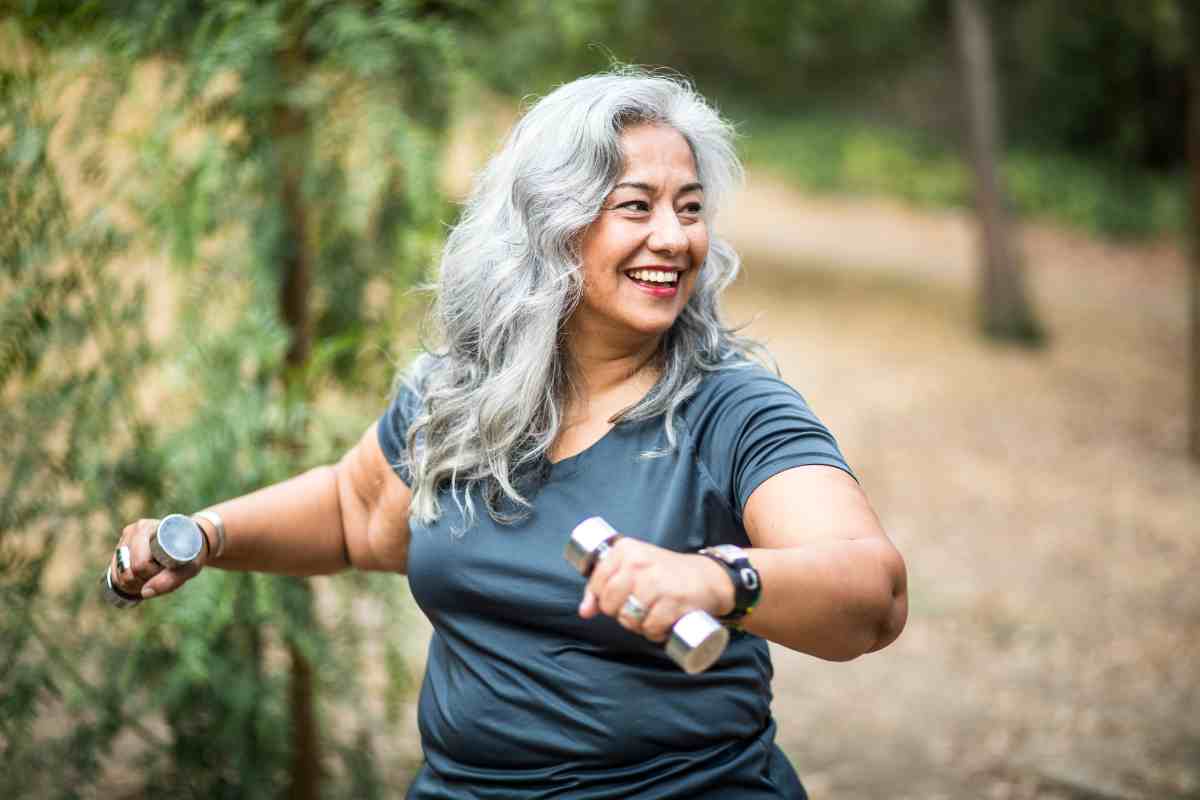The Benefits of Exercise for Pain Relief

[lwptoc labelHide=”hide”]
Harnessing the power of exercise for pain relief can supercharge your recovery and transform your life.
This excellent free way to alleviate pain deserves more attention. Dig in to find out more about the incredible benefits of exercise.
Exercise doesn’t always receive the recognition it deserves when it comes to managing chronic pain. That’s why it’s important for people suffering from chronic pain to realize just how beneficial exercise for pain relief can be for their condition.
Research has proven that exercising regularly aids in reducing disability levels associated with discomfort while also uplifting overall quality of life. The physical impact of exercise is undeniable too! It helps regulate symptoms connected to pain much more effectively.
Exercise and inflammation
One way that exercise can help relieve pain is by reducing inflammation in the body. [1]
Research has shown that even relatively low-intensity activities can be beneficial in reducing inflammation levels, with just 20 minutes of exercise per day being enough to positively affect inflammation. [2]
These activities can range from gentle stretching or walking to swimming and aquatic therapy. Additionally, studies have found that engaging in physical activity at least three times per week can help reduce inflammation levels.[3]
Exercise and Blood Flow
Exercise can also help increase blood flow to affected areas of the body, which can help reduce pain and stiffness.[4]
When you exercise for pain relief, your body releases endorphins, which are natural painkillers[5][6]. Endorphins are released by the hypothalamus and pituitary gland in response to pain or stress, and they help relieve pain, reduce stress, and improve your sense of well-being[5][6]. Exercise for pain relief also reduces levels of the body’s stress hormones and stimulates the production of endorphins, which can elevate your mood[7]. So, exercising regularly can help you manage stress and improve your overall health and well-being[8].
Exercise for Pain Relief Builds Joints
When you exercise, the muscles surrounding and supporting your joints become stronger. [9] This added muscle mass helps secure the joints from harm, which eases aches and stiffness. Therefore, strengthening these muscles through physical activity can be an effective way to reduce joint pain!
Regular exercise can strengthen key supportive muscles, restore flexibility, and improve overall core strength and balance[10].
Therefore, strengthening these muscles through physical activity can be an effective way to reduce joint pain!
Exercise for Pain Relief Promotes Activity
Another way that exercise can help manage pain is by improving overall strength and flexibility. When you have pain, it’s easy to fall into a cycle of rest and inactivity, which can lead to muscle loss and atrophy. This can ultimately make pain symptoms worse by reducing overall strength and flexibility. Exercise for pain relief can help prevent muscle loss and atrophy by building strength and flexibility, which can help reduce pain and improve overall functionality.
Inactivity can cause pain and discomfort in various parts of the body, including the back, knees, and neck[11][12]. It can also lead to chronic pain and deterioration of bodily functions such as muscles, skeleton, gastrointestinal system, and nervous system when it could have been quite easily been reversed or prevented with exercise for pain relief [13][14].
In addition, physical inactivity can increase the risk of certain cancers and add to feelings of anxiety and depression[15].
Exercise Control Over Your Condition
In addition to helping manage pain symptoms, exercise for pain relief can also have a positive impact on one’s overall sense of well-being and self-image. Engaging in regular physical activity can boost self-confidence, promote a sense of accomplishment and improve overall mood. When we feel good about ourselves physically, it can spill over into other aspects of our lives, leading to increased motivation and productivity.
Moreover, taking the time to reflect on our achievements and progress during exercise can further boost our self-image. Celebrating small victories, like running an extra minute or lifting heavier weights, can help us feel more capable and confident in our abilities.
And when we feel good about ourselves, it shows. The world smiles back at us, and others are more likely to perceive us in a positive light. We may even notice physical changes, such as improved posture or a more radiant complexion.
By prioritizing exercise and making it a part of our daily routine, we can reap the benefits of improved self-image, an increased sense of control over pain symptoms, and an overall improved quality of life. So go ahead and hit the gym – not only will you look great, but you’ll feel great too.
Energy Boosting Exercise Provides Pain Relief
 ATP is a complex molecule that is essential for our bodies to function properly. It is produced in the mitochondria, the energy powerhouses of our cells. ATP is made up of three parts: adenine, a nitrogenous base; the sugar ribose; and three phosphate groups. These phosphate groups are the key to ATP’s function as energy currency.
ATP is a complex molecule that is essential for our bodies to function properly. It is produced in the mitochondria, the energy powerhouses of our cells. ATP is made up of three parts: adenine, a nitrogenous base; the sugar ribose; and three phosphate groups. These phosphate groups are the key to ATP’s function as energy currency.
During exercise, your body uses large amounts of ATP to fuel muscle contractions. As you exercise, the concentration of ATP in your muscles decreases, and the concentration of ADP and phosphate increases. This triggers a process called cellular respiration, in which the body breaks down carbohydrates, fats, and proteins to produce more ATP.
This process occurs in the mitochondria, which use oxygen to produce energy in the form of ATP. As you continue to exercise, your body’s demand for ATP increases, and so does your breathing rate, as your lungs work to bring in more oxygen. [16]
By understanding the important role of ATP in exercise, we can better understand the importance of fueling our bodies with the nutrients needed to maintain ATP production. Eating a balanced diet rich in complex carbohydrates, healthy fats, and protein can help ensure that your body has the fuel it needs to produce ATP and power your workouts.
So, the next time you hit the gym, remember that every movement you make is powered by the breakdown of ATP, and by fueling your body properly, you can ensure that you have the energy you need to excel in your workout.
How does ATP create energy during exercise?
During aerobic exercise, the body uses oxygen to break down glucose and stored fats to produce ATP. This system can provide energy for longer-duration exercises, such as running or cycling.
During high-intensity exercise or weight lifting, the body uses the anaerobic system to produce ATP. This system does not require oxygen and uses stored creatine phosphate and glycogen to produce ATP quickly. However, this system can only provide energy for short bursts of intense activity before depleting.
Regular exercise can improve the body’s ability to produce and use ATP more efficiently, allowing you to exercise longer and more intensely without becoming fatigued as quickly. Additionally, increased muscle mass resulting from regular exercise can help store more creatine phosphate and glycogen, resulting in increased ATP production during high-intensity activities.
Exercise really is an essential part of any disease regeneration program.
The Various Physical Benefits of Exercise for Pain Relief
Improved flexibility
Increased strength
Reduced disability.
Better join support
Fewer falls
Increased longevity
Low-Impact Exercise Routines for Pain Relief
One way for those experiencing pain to reduce symptoms through low-impact exercise is by engaging in a routine that includes walking, cycling, and yoga.
Walking
 Walking is a great low-impact exercise that can be beneficial to those with chronic pain. It is an activity that can be easily incorporated into your daily routine and doesn’t require any special equipment or gym membership. Walking has numerous health benefits including helping to strengthen the muscles in the hips and legs, improving cardiovascular health, and reducing stress and anxiety.
Walking is a great low-impact exercise that can be beneficial to those with chronic pain. It is an activity that can be easily incorporated into your daily routine and doesn’t require any special equipment or gym membership. Walking has numerous health benefits including helping to strengthen the muscles in the hips and legs, improving cardiovascular health, and reducing stress and anxiety.
For those who have chronic pain, it can be overwhelming to think about beginning an exercise routine. However, starting with short and slow walks can be an excellent way to begin. Begin with a 10–15 minute walk at a comfortable pace and gradually increase the duration, frequency, and intensity of your walks as your body becomes more accustomed to the activity. By starting slowly and increasing gradually, you can reduce the risk of injury and make it easier to stick to your walking routine over time.
It is important to wear comfortable shoes with good support when you are walking and to walk on flat surfaces initially. You can also try using walking poles or hand weights to add resistance and challenge your muscles in the upper body.
In conclusion, walking is an excellent low-impact exercise that can help improve muscle strength, cardiovascular health, and mental well-being. By starting slowly and building gradually, those with chronic pain can reap the benefits of walking while minimizing the risk of injury. So, take the first step towards a healthier lifestyle and start walking today!
Cycling
 Cycling is an excellent low-impact exercise that can help reduce pain symptoms and improve cardiovascular health. It can be done outdoors or indoors with a stationary bike, making it a versatile option for people of all ages and fitness levels. Cycling is particularly beneficial for strengthening the lower body muscles, including the glutes, hamstrings, and quadriceps.
Cycling is an excellent low-impact exercise that can help reduce pain symptoms and improve cardiovascular health. It can be done outdoors or indoors with a stationary bike, making it a versatile option for people of all ages and fitness levels. Cycling is particularly beneficial for strengthening the lower body muscles, including the glutes, hamstrings, and quadriceps.
If you are new to cycling, it’s important to start slowly and gradually increasing the duration and intensity of your rides. Start with short rides of 15 minutes or less and gradually work up to longer rides as your body becomes more accustomed to the activity. It’s also important to ensure that your bike is properly fitted to your body to prevent unnecessary strain on the joints.
As you become more comfortable with cycling, you can increase the intensity of your rides by incorporating interval training or riding on hilly terrain. This will challenge your muscles and cardiovascular system, helping to improve your overall fitness.
Cycling has many benefits beyond pain management, including improving heart health, reducing stress and anxiety, and promoting weight loss. It is also a social activity that can be enjoyed with friends or family.
Yoga
Yoga is a great low-impact exercise that can help improve flexibility, strength, and balance while also reducing stress levels. It is a form of exercise that combines physical movement with breathing techniques, meditation, and relaxation, making it a wonderful form of exercise for both the mind and body.
Beginners should start with basic poses and gradually move on to more challenging poses. Poses can be modified to suit individual needs and capabilities, making it a great exercise option for people of all ages and fitness levels.
Yoga is particularly beneficial for those with chronic pain, as it helps to improve flexibility in the muscles and joints, which can help reduce pain symptoms. Additionally, the relaxation techniques used in yoga can be beneficial in reducing stress and lowering levels of the stress hormone, cortisol.
Yoga can also help improve balance and postural alignment. This can be particularly beneficial for older adults who are at an increased risk of falls or those with back pain or posture issues, as it can help to strengthen the muscles that support the spine and improve overall posture.
By practicing yoga regularly, you can transform your mind and body for optimal health and well-being.
Swimming
 Swimming is an ideal low-impact exercise option, as it provides a full-body workout while significantly reducing stress on the joints and muscles.
Swimming is an ideal low-impact exercise option, as it provides a full-body workout while significantly reducing stress on the joints and muscles.
Swimming can also promote healthy heart and lung function, and it can help improve cardiovascular fitness. The resistance provided by the water can help strengthen muscles and improve endurance, while the buoyancy offered by the water helps support body weight, reducing the impact on joints.
Swimming can also be beneficial for reducing stress levels. The repetitive rhythm of swimming can be meditative, helping to calm the mind and promote relaxation. Additionally, the release of endorphins during exercise can help improve mood and reduce symptoms of anxiety and depression.
Overall, swimming is a great low-impact exercise option that can provide numerous health benefits, both mental and physical. Whether you are looking to reduce stress, improve cardiovascular health, strengthen muscles, and improve joint mobility, regular swimming can help you achieve your goals.
With a variety of strokes and exercises to choose from, swimming is an endlessly versatile and rewarding form of exercise that is well-suited for people of all ages and fitness levels.
Getting Started with Exercise When You’re in Pain
One of the biggest obstacles to starting an exercise routine when you’re in pain is the fear of exacerbating your symptoms.
Starting an exercise routine when you’re in pain can feel like a daunting task. However, with the right resources, guidance, and support, it can be done. Here are some tips on how to get started with exercise when you’re in pain:
1. Work With a Physical Therapist
A physical therapist is essential for getting started with exercise when you’re in pain. A physical therapist can help design a targeted program that focuses on improving your symptoms while keeping you safe and injury-free.
2. Start Slowly
Slow and steady wins the race when it comes to starting an exercise routine when you’re in pain. Don’t push too hard, but instead listen to your body and start with exercises that feel comfortable.
3. Focus on Form
Focusing on good form and posture during exercises is essential when you’re in pain, as poor posture can aggravate existing symptoms or cause new ones. Working with a physical therapist can help make sure you have the right form for each exercise.
4. Modify Your Routine
As you progress through your exercise routine, be open to trying different movements and modifying the intensity of certain exercises if needed. You can also vary your routine by introducing new exercises or adding challenges such as weights or cardio intervals.
5. Stay Motivated
Finding ways to stay motivated is essential when you’re in pain. Consider breaking up your workouts into smaller chunks and make a plan to track your progress. You can also find an exercise buddy or group to help keep you motivated and accountable.
6, Accountability Coaching
Accountability coaching is an effective tool for those who are suffering from chronic pain and are looking to start exercising in order to improve their condition. [17] Studies have shown that having an accountability partner or coach can help those with chronic pain become more active, as they will be encouraged to stay on track with their goals and be held accountable for the progress they make.
The main benefit of accountability coaching when it comes to managing chronic pain is that it provides much-needed motivation, which can often be hard to come by when one is dealing with such a debilitating issue. With the help of a coach, individuals suffering from chronic pain can find the strength and discipline required to begin exercising regularly and enjoy the many physical and mental benefits that come along with it.
Moreover, an accountability coach can provide support by offering personalized approaches and advice tailored specifically to the individual’s needs. They can offer guidance on the best way to exercise safely and effectively in order to avoid overexerting oneself or making their symptoms worse – something which often happens when we try to take it upon ourselves without any guidance. So if you’re looking for a way to take control of your chronic pain through exercise, an accountability coach could be exactly what you need!
Exercising when you’re in pain can be a challenge, but with the right resources, guidance, and support it is possible. Working with a physical therapist and taking the steps outlined above can help you get started safely so that you can start feeling better and gaining the benefits of exercise.
By following these tips, those experiencing pain can get started with an exercise in a safe and effective way. With time and consistency, regular exercise can help reduce pain symptoms, improve quality of life, and promote overall physical and mental well-being. Click here to get on board with a pain-killing accountability coaching course.
The Importance of Stretching for Pain Relief
 Stretching is a vital part of any exercise routine when it comes to reducing pain and promoting overall physical health. It is an activity that involves lengthening and elongating muscles to improve flexibility and joint range of motion. Here’s how to properly stretch and the benefits stretching provides.
Stretching is a vital part of any exercise routine when it comes to reducing pain and promoting overall physical health. It is an activity that involves lengthening and elongating muscles to improve flexibility and joint range of motion. Here’s how to properly stretch and the benefits stretching provides.
To properly stretch, begin each stretch slowly and hold for up to 30 seconds or more. Avoid bouncing, which can cause muscles to contract and increase the risk of injury. Remember to breathe deeply throughout each stretch and avoid locking your joints.
Stretching has many benefits for those experiencing pain, including reducing muscle and joint stiffness, improving circulation and range of motion, and helping to prevent injury. By regularly stretching, muscles become more flexible and better able to withstand the forces of exercise and daily life.
Stretching can also help reduce pain symptoms by relieving tension, stretching tight areas, and improving posture. By stretching tight muscles, you can reduce tension in the body, reducing pain in the process.
Finally, stretching is also beneficial for the mind, providing a sense of relaxation and calmness. When done mindfully, stretching can be an excellent way to improve mental and emotional well-being.
By incorporating stretching into your daily routine, you can improve flexibility, reduce pain symptoms, and promote overall physical and mental health.
Mindful Movement In Exercise for Pain Relief
 Mindful movement practices such as yoga, tai chi, and qigong can be powerful tools for managing pain and reducing stress. Not only are these activities low-impact and accessible to all ages and abilities, but they also provide a range of physical, mental, and emotional benefits.
Mindful movement practices such as yoga, tai chi, and qigong can be powerful tools for managing pain and reducing stress. Not only are these activities low-impact and accessible to all ages and abilities, but they also provide a range of physical, mental, and emotional benefits.
For those experiencing pain, mindful movement practices can help reduce tension in the body and improve mobility. By focusing on slow movements and taking time to connect with your breath and body sensations, you can become more aware of what is happening in your body. This awareness can help bring relief from chronic pain as it helps you identify where tension or tightness is held in the body. As well as addressing physical pain directly, mindful movement practices also help to cultivate relaxation which in turn reduces overall stress levels.
In addition to providing direct physical relief from pain symptoms, mindfulness-based exercise practices have been found to have positive impacts on mental well-being too. When done with intentionality rather than just treating it like another exercise routine, mindfulness through movement has been linked to improved calmness, clarity of thought, and a renewed sense of ease.
Finally, mindful movement helps us foster a connection between our minds and bodies; helping us develop greater self-awareness and understanding of how we move through life both physically and emotionally.
Overall, mindful movement practices like yoga, tai chi, or qigong offer many benefits for those dealing with chronic pain or stress levels. By moving with intentionality rather than just going through the motions of an exercise routine can help improve physical mobility while cultivating emotional resilience toward pain symptoms.
So what are you waiting for?
For those experiencing arthritis pain, regular exercise can be a powerful tool for managing symptoms and improving overall physical health. Exercise can help strengthen the joints, increase flexibility and range of motion, reduce inflammation, and improve overall well-being. Additionally, engaging in physical activity such as yoga or tai chi can also help reduce stress levels and cultivate mental clarity. Overall, exercising regularly is essential for combating arthritis pain in both the short and long term – so if you’re looking to find relief from your pain then it’s time to start moving!
To find out more about exercise pop over to our exercise section! Or if you really struggle with getting motivated or sticking to your goals try our accountability training package where Wade will work with you to reach your goals.

